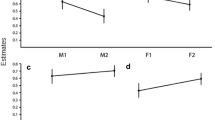Abstract
The effects of several environmental factors on the postweaning growth of wild Alpine marmots were investigated. Factors considered were year of birth, sun exposure in the home range, litter size, and sex of young. Components of growth were juvenile mass at emergence from the natal burrow (as a result of preweaning growth) and postweaning growth rate. We also considered the length of the active season during which growth occurs. Mass at emergence and postweaning growth rate varied according to year of birth, were higher in south-facing than in north-facing home ranges, and were higher in small litters. Mass at emergence was higher for males than for females. We suggest that environmental factors affected the juvenile growth pattern through influences on maternal body condition. Our results support Trombulak's hypothesis that mothers maintain as many young as physiologically possible. We suggest that mothers in poor condition sacrificed the mass of their offspring rather than their number. A body mass sexual dimorphism of juveniles occurred at emergence, suggesting that mothers may provide more care for their male than their female offspring.
Similar content being viewed by others
Author information
Authors and Affiliations
Additional information
Received: 9 June 1997 / Accepted: 22 September 1997
Rights and permissions
About this article
Cite this article
Allainé, D., Graziani, L. & Coulon, J. Postweaning mass gain in juvenile alpine marmots Marmota marmota . Oecologia 113, 370–376 (1998). https://doi.org/10.1007/s004420050388
Issue Date:
DOI: https://doi.org/10.1007/s004420050388




